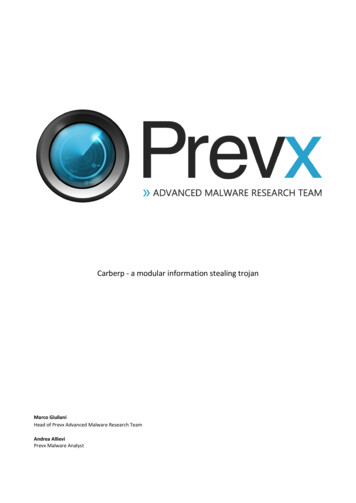
Transcription
Carberp - a modular information stealing trojanMarco GiulianiHead of Prevx Advanced Malware Research TeamAndrea AllieviPrevx Malware Analyst
PREFACENowadays most banking operations and payments are done on the web, through e-banking services andonline payment solutions, like MoneyBookers or Paypal. Since online transactions are increasing theirvolume, malware authors are focusing more and more on the development of malicious software able tosteal sensitive data from the infected computers.Today there are several kits sold online, botnet solutions available to everyone, developed to build up in acouple of minutes a brand new version of a specific Trojan able to hide itself from antivirus scanners andarmored by some interesting features like remote control and sensitive data stealing routines.With an expense of just 700/800 dollars – such kits are not expensive - a potential attacker could gainseveral thousands of dollars and he could build up his own botnet that can be then sold or rent, or yet usedto attack sensitive websites.The two most infamous botnet kits available online were ZeuS and SpyEye, and we already talked aboutthem in our blog posts here and here.It looks like that between Q3/Q4 2010 ZeuS author decided to stop the development of his trojan andchose to sell the source code to the authors of SpyEye, giving to it the leadership of info stealing trojans.We have already analyzed the last variant of SpyEye with ZeuS enhancements here in our Prevx blog.During the second half of 2010 we have monitored the growth of a new trojans available on theunderground market: it is called Carberp.After some cycles of hard development, today Carberp has probably become the second worst threat tocustomers data, following SpyEye.In this paper we are going to analyze this trojan in depth, looking at how it is evolved and what we canexpect in the future from the team behind this trojan.2
DROPPER ANALYSISThis trojan is usually dropped by fake webpages containing exploit codes or spread through social engineering. The file itselfchanged many times during the last few months.The dropper is crypted by a strong encryption layer. While the encryption itself isnot really complicated, a manual analysis approach is not trivial because of several tricks implemented by the developer during thelayer development.By analyzing droppers caught during past few months, we have seen a wide range of tricks implemented in the decryption layer tomake the unpacking job a challenge. In some variants the code was totally messed up. Usually this kind of spaghetti code is enoughto stop most reversers from manually analyzing the code.The dropper implements a number of fake API system calls, using invalid parameters. This trick is used to fool antivirus emulators,to stop them from emulating the trojan code. Antivirus emulators usually try to statically or dynamically emulate Windowsbehavior so that the malicious code can be executed in a controlled environment and it can be checked by the antivirus engine.System emulation is often far from being perfect, and the emulation of system calls doesn’t really emulate all possible situations.By implementing several fake API calls with invalid parameters, the trojan tries to stop antivirus emulators from working correctly.It tries to call uncommon and more rare Windows APIs, those APIs that are sometimes not emulated by antivirus emulators.Carberp doesn’t import API functions by using documented ways. Instead it manually parses system libraries to import needed APIaddresses. It implements a hashing routine to hide the API names that it’s going to import so that it slows down the analysis of themalicious code. Instead of passing the name of the API that needs to be imported, the trojan uses a hash that is calculated from thename of the function. The hashing routine used by the dropper we have analyzed is the one showed in the image below:EAX register stores the hash. It is rotated left by 7 on every loop and it is then xor’d with the string character pointed by the ESIindex. It is a common technique used by malware. Carberp will use this technique again in the unpacked code – however it willimplement a different hashing algorithm.The encryption layer is divided into two parts: the first part tries to fool manual analysis and automated emulators analysis – asdescribed above.The second part is the actual decryption layer, which is based on mathematical instructions obfuscated by junk code. After thedecryption is finished, the real trojan code is executed.3
FIRST STAGE TROJAN EXECUTIONHere we are at the real trojan code. PE static analysis shows that there isn’t any import table directory. The trojan manually importsall needed APIs by parsing the needed system libraries. This is the technique already used in the decryption loader code, it justchanges the hashing algorithm. The new one is showed below:The trojan imports all needed APIs every time they are needed.Carberp will place itself inside current logged in account startup folder, to make sure it will start at next startup. The used file nameis arbitrarily chosen by the attacker during the trojan build up procedure through the Carberp creation kit. It usually uses one ofWindows system file names.To hide itself in the system the trojan will use user mode rootkit techniques. We’ll analyze them later in this paper.Carberp is a fully modular trojan, able to download and execute new plugins from the command and control server. Indeed thetrojan already contains two plugins embedded in its code.Every plugin is encrypted by using another encryption algorithm. This is the reason why the embedded plugins are well hidden fromthe user.Carberp plugins have a common file format, which is based on a 14 bytes header followed by the encrypted code. The 14 bytesheader contains the encryption key and a string used to identify new downloaded plugins: ‘BJB’.The encryption algorithm is almost trivial, yet it is quite effective. It is a xor algorithm based on the encryption key and indexpositions of the involved bytes. The algorithm is showed below:4
With the help of the reversed algorithm, we can extract the two embedded plugins and analyze them.The first plugin is r00f dll.dll and it is extracted at the trojan startup.Carberp trojan is a pure user mode trojan, which means it is able to run completely in user mode, even inside limited accounts. Ittries to run some specific code in kernel mode, to restore SSDT hooks, if they are present.r00f dll.dll’s job is executing code in kernel mode to restore original System Service Descriptor Table. It tries to unhook followingnative penProcessNtTerminateProcess
This technique would allow the Trojan to evade from security software that monitor the system by hooking the above kernelfunctions.The trojan maps the original kernel file in memory and gets original kernel pointers, then it prepares the code to be executed inkernel mode. Here the plugin tries to use two different methods to execute code in kernel mode.First attempt is done by using an old Windows vulnerability - MS08-025 - already patched by Microsoft. If the system has not beenpatched, the vulnerability allows the trojan to gain system privileges and run code in ring0.If the exploit has been patched, the trojan tries to get debug privileges by calling RtlAdjustPrivilege and then tries to write insidethe kernel memory by invoking ZwSystemDebugControl API with SysDbgWriteVirtualMemory parameter.These attacks are executed only on Windows 2000, Windows XP and Windows 2003 operating systems. If the trojan is running in alimited account and the system is fully patched, these attacks won’t go succeed.The second embedded plugin, screens dll.dll, is used to capture display screenshots.After the r00f plugin has been executed, Carberp starts its infection routine. To better hide its behavior, Carberp does not executeits payload from its process, but instead it spawns a new explorer.exe process in a suspended state. This process will host themalicious code.After the explorer.exe process has been created, Carberp creates a new section object and maps itself inside this newly createdsection. Then, this section is mapped into the explorer.exe process through a call to ZwMapViewOfSection.The malicious code has been injected inside the explorer.exe process. To start it, Carberp has been observed using two differenttechniques. The first technique is hijacking explorer.exe entry point in memory, patching it with a PUSH/RET instruction to redirectthe flow code to the injected malicious code.6
Original EntrypointHijacked EntrypointThe second technique used is queuing an APC routine to the main explorer.exe thread by calling ZwQueueApcThread. Then bothtechniques start the suspended explorer.exe process by calling ZwResumeThread.The original Carberp dropper terminates, it is now running inside its child explorer.exe. It will then inject its code inside the originalsystem’s explorer.exe process through a CreateRemoteThread call. To find out the original explorer.exe process, the trojan looksfor the Shell TrayWnd class name.The trojan creates a new instance of svchost.exe process, where it will inject the code able to communicate with the command andcontrol server.USER MODE HOOKSCarberp acts as an information stealing trojan and a user mode rootkit. To hide itself inside the system, it’ll inject a copy of itself inevery running process and it will hook ntdll.dll NtQueryDirectoryFile API. By hooking this system function, the trojan is able to hideits file from the user.From a technical perspective, the hook replaces the standard SystemCallStub address with its own routine:Original ZwQueryDirectoryFileHijacked ZwQueryDirectoryFileThe call dword ptr [edx] instruction will invoke the trojan routine, able to filter out the trojan file from file enumeration.While this technique is easy to be bypassed in several ways – direct sysenter call, direct file opening, unhooking – it is actually quiteeffective and it does its job.7
The trojan hooks ntdll.dll NtResumeThread in the same way.Carberp uses a a Man-In-The-Browser approach to steal information data. It hooks following TranslateMessageInternetWriteFile, TranslateMessage and CreateFileW hooks are set on the fly if one of the following strings are found in the URL:*cyberplat**/ibc/**bsi.dll*Previous variants of the trojan hooked only HttpSendRequestA/W and HttpSendRequestExA/ExW APIs – still TranslateMessage andCreateFileW were set on the fly. Moreover those previous versions tried to steal information data only if *cyberplat* or *bsi.dll*strings were found in the URL. Current Carberp releases upload every relevant data to the collector server, withparticular attention to the strings listed above.There isn’t any watchdog thread monitoring the presence of the malware hooks, so a trivial code restore can help in fixing themalware.C&C COMMUNICATIONCarberp is not just an information stealing trojan, it is a remote controlled malware that turns the infected PC in a zombie. Carberpcan communicate with a list of servers, usually embedded inside the binary.In previous variants of the trojan, those servers were not encrypted, and they could be read in plain text.More updated variants of Carberp encrypt them with a trivial xor-based encryption algorithm.8
The algorithm –and relative decoded string – are showed below:Carberp can be configured to contact even more servers.When the infected computer contacts the C&C for the first time, the trojan will send back to the server some information about thevictim machine – operating system version, process lis, along with a unique ID calculated from the infected computer.The trojan could download a specific configuration file from the server. The file name of the configuration file is stored inside thetrojan binary and it’s encrypted using the same algorithm described in the previous page. This configuration file name will be evenused when generating the unique name of the infected machine used by the C&C server.Then the trojan will contact a specific webpage of the C&C server - domain /set/task.html – looking for specific commands fromthe server.The version of Carberp we have analyzed can receive the following commands: DownloadupdategrabberloaddllstartsbgetwmIt can update itself, download and execute new executable files or load dll, and even start a remote VNC session by downloading aspecific Carberp plugin (vnc.plug).As written before in the paper, Carberp is a fully modular trojan, able to download and execute specific plugins written by Carberpdevelopers.We have been able to download and analyze three of most used plugins. They are passw.plug, stopav.plug, miniav.plug. All theseplugins are encrypted with the encryption algorithm described earlier in this paper.Stopav.plug is a plugin used to disable a number of specific antivirus software. Currently it tries to disable following securitysoftware: 9Arcavir AntivirusAvast4 AntivirusAvast5 AntivirusAVG Antivirus
Avira AntivirusBitDefender AntivirusDr.Web AntivirusMcAfee AntivirusMicrosoft Security EssentialsEset AntivirusEset Smart SecuritySophos AntivirusThe plugin looks into the Windows registry looking for specific registry keys related to these antivirus products. If found, thecommon procedure is to try to disable the security software by creating a specific antivirus process in a suspended state and theninjecting there the payload to delete one or more antivirus core files. Process is then resumed.Security softwareArcavir AntivirusNewly created processarcavir.exeAvast4 AntivirusashDisp.exeAvast5 AntivirusAvastUI.exeAVG AntivirusAvira AntivirusBitDefender Antivirusavgtray.exeavconfig.exelivesrv.exeDr.Web AntivirusSpIDerAgent.exeMcAfee AntivirusMicrosoft Security EssentialsEset AntivirusEset Smart SecuritySophos Antivirusmcshell.exemsseces.exeAlMon.exestopav plugin screenshotThis plugin has been written in Borland Delphi.10Files attempted to be deletedadc.%# .462update tmp.exe rc.dllupgrepl.exev live l\updfiles\upd.ver\updfiles\upd.verscf.dat
The second plugin, written in Borland Delphi too, is miniav.plug. This plugin is responsible of scanning the system looking for othertrojan infections. It looks for – and try to clean – following trojans: rZeuSminiav plugin screenshotThe plugin also checks the Image File Execution Options registry key, looking for “Debugger” value inside every subkey. This is acommon technique used by malware to deny the creation of specified processes or to get their code to be executed when thespecified process is run.The third plugin, passw.plug, is a grabber able to scan the infected PC looking for passwords and user accounts. It can grab a lot ofinformation from an infected PC, for example: Live Messenger, Yahoo, Trillian, Pidgin, MySpace, Gaim, QIP, Odigo, ICQ, GTalk, Gizmo, Jabber, Gadu-Gadu, AOL, Mirandaaccounts; Password and forms data saved in most common browsers (Opera, Internet Explorer, Safari, Firefox, Chrome); Mail accounts and relative passwords from most common e-mail clients (Outlook, Windows Live Mail, The Bat!, Becky,Eudora, Mail.Ru, IncrediMail, PocoMail, ForteAgent, Scribe, POP Peeper, MailCommander etc ); User accounts and passwords from most common FTP clients (CuteFTP, WS FTP, FileZilla, FTPCommander, BProofFTP,SmartFTP, CoffeeCup, CoreFTP, Frigate3, UltraFXP, FlashFXP, FTPRush, WebSitePublisher, BitKinex, FreeFTP, WinSCP,TotalCommander etc ); System Information along with credential passwords for desktop remote control, VNC passwords, Cisco VPN accounts;All stolen information are stored in a database and uploaded to the remote server.11
CONCLUSIONSWhile SpyEye leads the world of infostealing trojans after ZeuS code has been sold, Carberp silently appeared on the undergroundmarket and showed the world a lot of potential.Its modular structure along with the ability to run even in limited accounts and the active development team behind it make thistrojan a very dangerous threat.Its encryption layer looks very effective in bypassing classic antivirus scanners, showing the need of a multi-layered securityapproach to fight against today’s threats.Prevx SafeOnline has been able to proactively protect our customers' navigation sessions from Carberp infostealing hooks –successfully preventing it from stealing bank accounts and passwords put in the browser while surfing on the online bankingwebpage.We expect to see Carberp to be much more widespread during 2011, quickly becoming one of the top infostealing threats.ABOUT PREVXPrevx provides cloud-based products with unparalleled capabilities for protecting consumers, SMEs and enterprises,banks, and government organizations from the latest malware threats.The entire Prevx suite is underpinned by its award-winning flagship security agent, Prevx 3.0, and connects to theworld's largest cloud-based threat database. Prevx 3.0 is the world's smallest, fastest, and lightest endpoint securityagent yet its detection, protection and removal capabilities rival the largest antivirus solutions. Prevx specializes indetecting zero day attacks, reducing the time exposed to danger and providing real-time protection against the latestand the most malicious forms of malware, including keyloggers, Trojans, and rootkits - catching the threats that aremissed by traditional antivirus providers.Prevx is a division of Internet security service company Webroot. With its main operations in the United Kingdom,Prevx products are also sold and supported across Europe and in the United States. Before acquisition by Webroot in2010, Prevx was formed by IT entrepreneur Mel Morris who acquired Immunify Ltd in 2005 and re-launched it asPrevx. Now vice president and general manager of the Prevx division at Webroot, Morris named Prevx to reflect theorganization's mission to help customers - from consumers and small businesses to the largest financial institutes andglobal organizations - to best protect themselves against the evolving and unknown nature of malicious software.Prevx: preventing the unknown.Prevx's family of security software is deployed by leading banks, enterprises, and government agencies and supportsover 15 million users worldwide.12
When the infected computer contacts the C&C for the first time, the trojan will send back to the server some information about the victim machine - operating system version, process lis, along with a unique ID calculated from the infected computer. The trojan could download a specific configuration file from the server.










